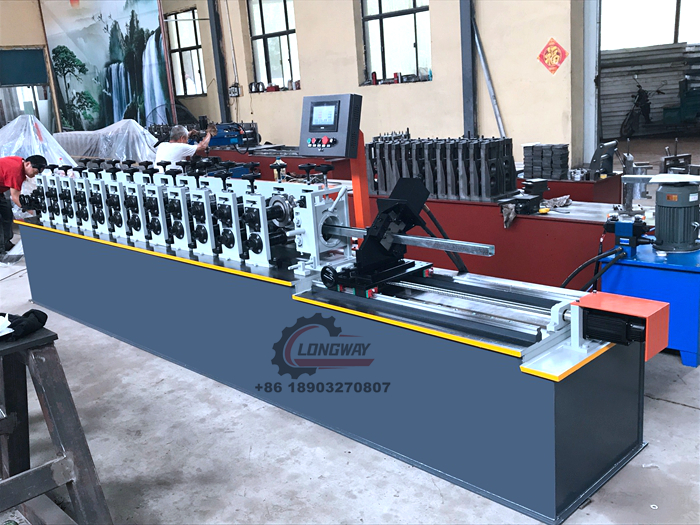c&z purlin roll forming machine
The Evolution and Importance of C&Z Purlin Roll Forming Machines
In the modern construction industry, the demand for high-quality structural components is constantly on the rise. Among these components, C and Z purlins play a pivotal role in providing support and stability to structures like warehouses, industrial buildings, and even residential projects. To meet this demand, C&Z purlin roll forming machines have emerged as essential tools in metalworking processes.
Understanding Purlins
Purlins are horizontal structural members that support roofing and wall sheeting. The shapes of these purlins can be categorized into two main types C-shaped and Z-shaped. C purlins are often used for roofs, while Z purlins are typically used for walls. The primary purpose of these purlins is to provide support for the structure while distributing loads from the roof or frame to the main structure. Their unique shapes ensure that the loads are managed effectively, thus enhancing the overall integrity of the building.
The Functionality of C&Z Purlin Roll Forming Machines
C&Z purlin roll forming machines are specialized equipment designed to convert flat steel sheets into precisely engineered C or Z shaped purlins. The rolling process begins with feeding flat steel into the machine, which then passes through a series of rollers. Each roller is designed to gradually shape the steel into the desired cross-section while maintaining consistent dimensions and tolerances.
These machines are equipped with advanced features such as 1. Adjustable Rollers These allow for quick changes to produce different sizes and thicknesses of purlins without the need for extensive tooling changes. 2. Auto-Feeding Systems These systems increase efficiency and reduce labor costs by automating the feeding process. 3. Computer Numerical Control (CNC) Many modern roll forming machines incorporate CNC technology, allowing for precise control over production parameters and the ability to store different profiles for quick retrieval.
The Benefits of Using C&Z Purlin Roll Forming Machines
1. Efficiency The automation of the roll forming process allows for higher production rates compared to traditional methods. This efficiency translates into lower manufacturing costs and quicker turnaround times for projects.
c&z purlin roll forming machine

2. Quality Assurance With the precision of roll forming machines, manufacturers can produce purlins with tight tolerances and uniformity. This quality is essential in construction, where structural integrity is paramount.
3. Versatility Many roll forming machines can be easily adjusted to produce both C and Z purlins, which makes them highly versatile tools for manufacturers. This adaptability allows companies to respond quickly to changing market demands and customer specifications.
4. Reduced Waste The roll forming process is a continuous method that minimizes material waste compared to cutting and welding individual pieces. This not only lowers costs but also promotes environmentally sustainable manufacturing practices.
Market Trends and Future Prospects
As globalization expands, the construction industry is witnessing significant growth, particularly in emerging markets. This surge in building activities is expected to drive the demand for C&Z purlin roll forming machines. Additionally, advancements in technology, including automation and smart manufacturing, are likely to enhance the functionality of these machines, further improving their efficiency and driving down costs.
Moreover, with the increasing focus on sustainable building practices, manufacturers are exploring the use of recycled materials in the production of purlins. C&Z purlin roll forming machines, which can easily accommodate various types of steel, will be integral in this shift towards greener practices.
Conclusion
C&Z purlin roll forming machines are a vital part of the modern construction landscape. Their ability to produce high-quality, precise purlins quickly and efficiently supports the increasing demand for durable and reliable building materials. As the industry evolves, these machines will play an even more significant role, shaping the future of construction and contributing to the creation of safe and sustainable structures around the world. Whether it's for industrial applications or residential buildings, the innovation in roll forming technology continues to make an impact, ensuring that purlins remain an essential component of contemporary construction.
-
Roof Panel Machines: Buying Guide, Types, and PricingNewsJul.04, 2025
-
Purlin Machines: Types, Features, and Pricing GuideNewsJul.04, 2025
-
Metal Embossing Machines: Types, Applications, and Buying GuideNewsJul.04, 2025
-
Gutter Machines: Features, Types, and Cost BreakdownNewsJul.04, 2025
-
Cut to Length Line: Overview, Equipment, and Buying GuideNewsJul.04, 2025
-
Auto Stacker: Features, Applications, and Cost BreakdownNewsJul.04, 2025
-
Top Drywall Profile Machine Models for SaleNewsJun.05, 2025








